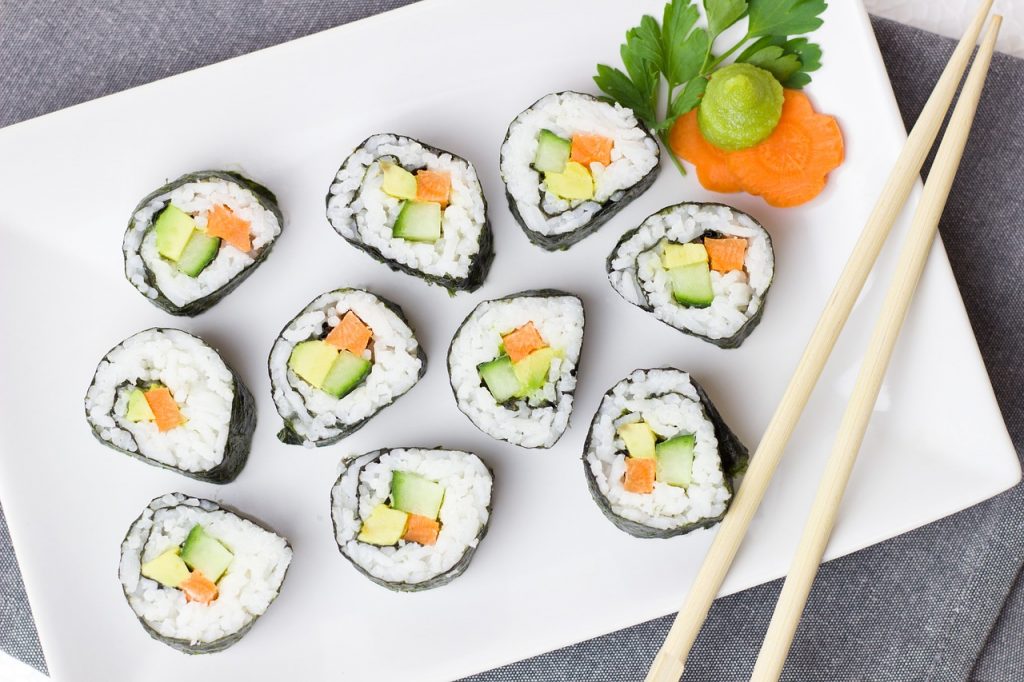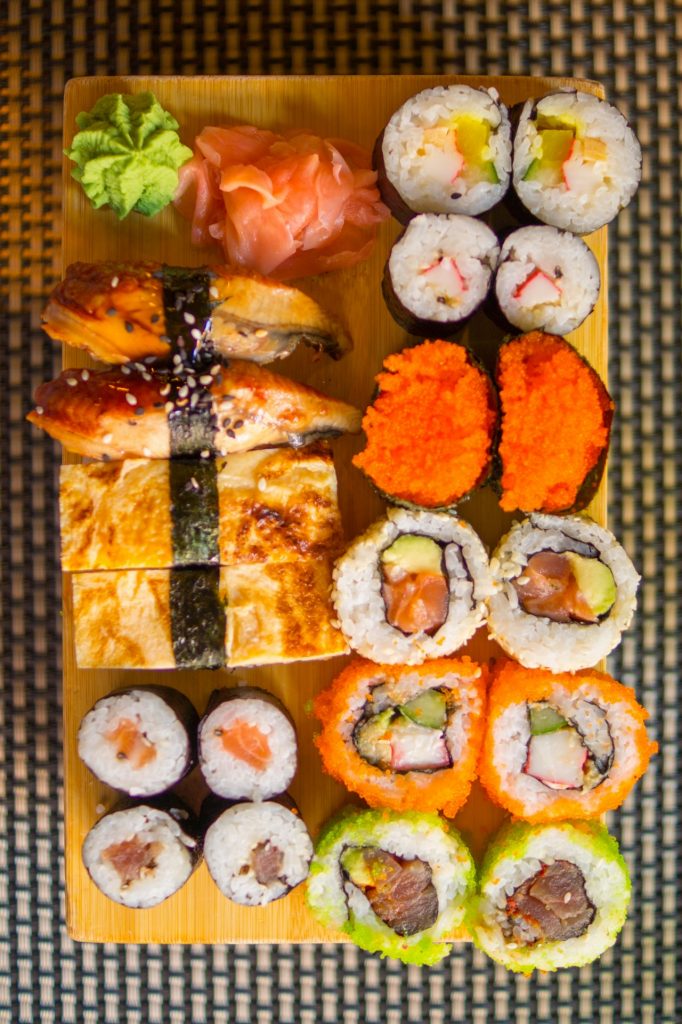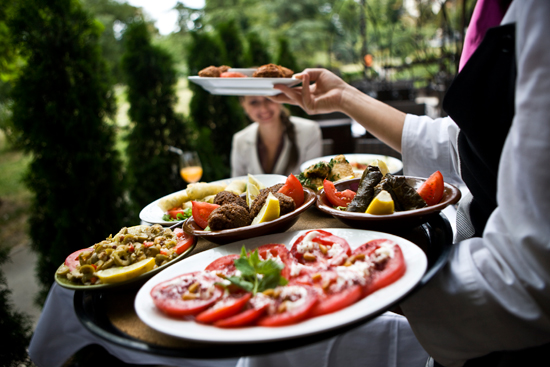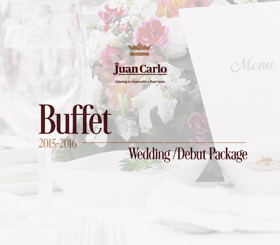What are the keys in mastering sushi etiquette?
- Call ahead of time to make a reservation and inform the chef of any food allergies you have.
- If you have a reservation, then you must show up.
- Prepare cash in case the restaurant doesn’t accept credit cards.
- Don’t wear strong perfume or cologne
- Order appetizers and drinks while waiting for the main dishes.
- Wipe your hands in the warm towels given
- Use your hands when eating sushi.
- Use chopsticks to eat sashimi and ginger. Place the chopsticks back on the ceramic holder when you are not using it.
- Eat the sushi from lighter to oilier.
- Have the first bite without condiments.
- Add only a little bit of soy sauce and dip the sushi on its fish side.
- Refrain from adding wasabi.
- Eat the sushi in one bite.
- Eat the ginger given with the sushi to cleanse you palate.
- Finish what you order.
- Show your gratitude to the chef. Buy him sake if you want to give him a tip.
Sushi, a popular type of food with its origins firmly rooted in Japan, has become a worldwide favorite. What was once a rather rare and local delicacy has now expanded into the palates of people all around the world. For example, here in the Philippines, sushi is a popular choice for corporate catering events – especially those being held in Manila. The same can be said for other countries such as the US, Canada, Australia, and even Hong Kong, where restaurant chains that serve Japanese cuisine exclusively are present and thriving.
What many people forget is that, despite sushi’s deceivingly simple appearance and balanced taste, there exists a whole culture that backs it up. Unlike most other dishes that may be eaten simply by placing it in one’s mouth, sushi has a particular set of customs attributed to it. Although it is not strictly enforced in other counties as it is in Japan, observing these rules will show you pay respect to its origins.
Here are the basic do’s and don’ts when eating sushi:
Before the Meal
Especially when you are looking to eat in a non-chain sushi restaurant it is important to give the venue a call. This is not just to make a reservation, but also to inform them of any restrictions in your diet. Japanese restaurants all have the strong desire to please their customers, but must know beforehand of any allergies and medical limitations in order to accommodate you to the best of its abilities.
When you make a reservation, be sure to show up because no-shows are looked down upon. You must understand that sushi must be served fresh and it will be wasted if you make them prepare your meals and then have to throw it away. Because of this waste of ingredient, you may still be asked to pay for the meal even if you didn’t show up.
Also, prepare some cash just to be sure because some sushi restaurant does not accept credit cards
Lastly, do not wear strong perfume or cologne when you are about to enter the restaurant. This is because sushi was made to be enjoyed, not only because of the taste, but also because of the smell. Carrying a strong aroma with you can ruin the experience for yourself and the people around you. This is especially true in the most upscale sushi restaurants where it is usually housed in small and narrow spaces.
Beginning the Meal
Like said above, the sushi will be made fresh by the chef. While waiting, it’s a good practice to order appetizers and drinks from the server should you feel the need to munch on something. Edamame (boiled soy beans), Suimono (clear broth), or Misoshiru (fermented soybean soup) are the common orders; as for the drinks green tea or water will suffice. Refrain from getting strong tasting foods as to not wash out the taste of the sushi once it comes – part of the joys of partaking in sushi is enjoying the fair taste of the fish and the rice.
Before starting the meal itself, wipe your hands with the warm towel provided and ensue your hands are clean. Pick up the sushi with your hands – this is considered as good manners because it keeps the perfect form the chef made the sushi in. But if eating sashimi or ginger, use chopsticks instead.
A side note: when the chopsticks are not in use, do not lay it flat on the table or on your plate. Use the ceramic holder that’s usually provided or make one using the paper wrapper the chopstick came in.
Eating
In Japanese culture, it is recommended to eat sushi in a certain order for the best experience. It is said that you must first start with whitefish and lighter sushi and work your way towards the oilier items like toro and grilled eel.
Eat the first bite without any added condiments or the like so you know how it tastes on its own. If it ends up not being to your taste, feel free to dip it into a bit of soy sauce – do not put it in rice down (and avoid mixing the wasabi in). Instead, flip it over and dip the fish side instead; see to it that you do not add too much sauce – this would insinuate that the chef did not do his job properly and that the sushi does not taste good. Traditionally, the chef would already add the necessary amount of wasabi to make the perfect sushi. Adding more would be insulting to the chef so as much as possible, try to eat it as it’s served. Place it on your tongue, face down for the full flavor and do your best to eat everything in one bite. If it’s not possible, do it in two and ask the chef to proportion it for you – understand that the chefs want to cater to your wants, it’s his job, so let him do it.
In-between bites of sushi, especially differing ones, pick up bits of ginger slices in order to cleanse your palate. Do this only when your mouth is empty and do not chew the ginger with the sushi.
Ending the Meal
Especially if you avail of the omakase course (which basically means “chef’s choice”) then you must absolutely finish what you order. Failure to do so is considered rude. This is why you want to call ahead of time regarding your dietary restrictions. If you are served something that you cannot eat and you don’t, then you will still be considered rude; the chefs will argue that you should have told them of any of your allergies and medical limitations.
When finished, give credit where it is due. Praise the chef if they created your perfect sushi, after all, there are few things in the world that can make one happier other than being told they’ve done a job well done. Should you find yourself wanting to express your sincere gratitude, don’t tip the chef. Buy him a drink (sake!) instead, and enjoy it together. Cheers!
Key Takeaway
So when you find yourself dining out in a high class restaurant or requesting it from your local caterer for your event – with friends or otherwise – remember these simple manners to avoid committing any social faux pas.











